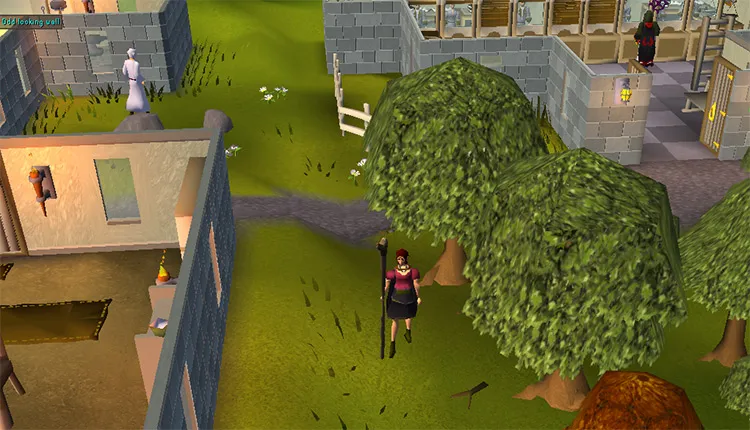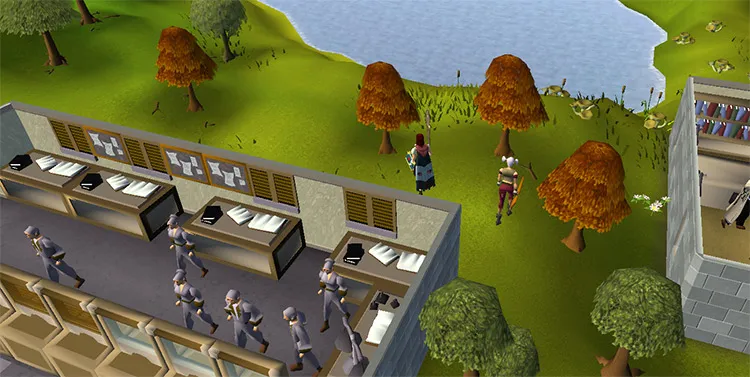Your cart is empty
Discover the Best Trees for Forestry in OSRS

Old School RuneScape (OSRS) has introduced a unique aspect of gameplay known as Forestry, which allows players to engage in tree planting and harvesting activities. This feature enriches the gaming experience by blending traditional skilling with a new layer of strategy and community interaction. As players explore the world of Gielinor, understanding the various tree types available for forestry is crucial for optimizing their woodcutting skills and maximizing resource gathering. This article delves into the intricacies of forestry and the advantages of different tree species.
In OSRS, the type of tree you choose to plant and harvest can significantly impact your efficiency and resource output. Each tree species offers distinct benefits, catering to different player needs and strategies. Here’s a breakdown of some key tree types commonly used in forestry:
- Regular Trees: These are the most basic trees found in Gielinor. They provide a steady supply of logs and are excellent for beginners. Regular trees can be cut down quickly, making them ideal for leveling up woodcutting skills from level 1 to 15.
- Oak Trees: Requiring level 15 woodcutting, oak trees yield oak logs that are more valuable than regular logs. They also offer a decent experience rate, making them a popular choice for players looking to balance efficiency with profit. Oak trees can be found in various locations, including the Tree Gnome Stronghold and Draynor Village.
- Willow Trees: With a woodcutting level of 30, players can begin harvesting willow trees. These trees are favored for their high experience rates and relatively quick cutting time. Willow logs are frequently used in fletching and crafting, making them valuable for players pursuing those skills.
- Maple Trees: At level 45 woodcutting, players gain access to maple trees, which provide maple logs. These logs are sought after for their high value and are used in various crafting and fletching recipes. Additionally, maple trees offer a solid experience rate, making them a great choice for mid-level woodcutters.
- Yew Trees: Requiring level 60 woodcutting, yew trees produce yew logs that are highly valuable in the game. These logs are primarily used for crafting bows and are in demand among players. Cutting yew trees can be a profitable venture, especially in high-traffic areas.
- Magic Trees: The highest tier, magic trees, require level 75 woodcutting. They yield magic logs, which are the most valuable logs in the game and are used for high-level crafting and fletching. Players often seek out magic trees for their profitability and the high experience they offer.
Choosing the right tree type based on your woodcutting level and goals is essential. Each type not only provides different resources but also impacts your overall gameplay strategy. By understanding the benefits of each tree species, players can enhance their forestry experience and make informed decisions to optimize their skilling efforts.
Top Trees for Woodcutting Experience

If you’re looking to maximize your woodcutting experience in Old School RuneScape (OSRS), you’ll want to focus on specific trees that yield the highest experience rates. Here’s a breakdown of the top trees that can help you level up your woodcutting skill efficiently.
- Willow Trees:
These trees are perfect for players between levels 30 and 99. They provide an impressive 67 experience per log and can be chopped quickly. Willow trees can be found near Draynor Village, making them an accessible choice.
- Maple Trees:
Once you reach level 45 woodcutting, maple trees become a viable option. Each log grants 100 experience, and they can be found in various locations, including the Woodcutting Guild.
- Yew Trees:
At level 60, yew trees offer more than just experience; they’re also a step towards higher-level logs. Each yew log gives you 175 experience, and you can find them in places like Edgeville and Varrock.
- Magic Trees:
For those at level 75 and above, magic trees are the holy grail of woodcutting. They provide a whopping 250 experience per log. You’ll primarily find them in places like the Tree Gnome Stronghold.
By focusing on these trees, you can significantly enhance your woodcutting experience, allowing you to reach higher levels faster!
Best Trees for Profit in OSRS
If you’re not just looking to level up but also to make some serious gold in OSRS, certain trees are more profitable than others. Let’s dive into the best trees for generating profit through woodcutting.
| Tree Type | Woodcutting Level | Profit per Log | Location |
|---|---|---|---|
| Yew Trees | 60 | ~£1,000 | Edgeville, Varrock |
| Magic Trees | 75 | ~£1,500 | Tree Gnome Stronghold |
| Teak Trees | 35 | ~£1,000 | Kourend |
| Maple Trees | 45 | ~£250 | Woodcutting Guild |
Among these options, magic trees and yew trees stand out for profit. They not only provide a good amount of experience but also fetch a high price on the Grand Exchange. Focusing on these trees can help you accumulate wealth while enjoying the woodcutting experience in OSRS.
Where to Find Each Tree Type
In Old School RuneScape (OSRS), knowing where to find specific tree types is crucial for efficient woodcutting. Different trees are located in various regions of Gielinor, and each type offers unique benefits. Here’s a quick guide on where to find the most common tree types:
- Regular Trees: These are abundant and can be found in many locations, including:
- Lumbridge Swamp
- Varrock south and north
- Draynor Village
- Woodcutting Guild
- Oak Trees: Oak trees provide a better experience than regular trees and can be found in:
- Draynor Village
- Varrock south
- Near the Woodcutting Guild
- Willow Trees: These are popular for training due to their fast respawn rate. Locations include:
- Draynor Village (by the river)
- Rimmington
- Near the Woodcutting Guild
- Maple Trees: Maple trees are ideal for mid-level training and can be found at:
- Yew Trees: Yew trees are sought after for their logs and can be found in:
- Varrock (north)
- Edgeville
- Near the Woodcutting Guild
- Magic Trees: The rarest of the common trees, Magic trees can be found in:
By knowing these locations, you can plan your woodcutting trips efficiently and maximize your experience gains.
Tips for Efficient Woodcutting
If you’re looking to level up your woodcutting skill in OSRS, efficiency is key. Here are some handy tips to help you cut logs like a pro:
- Use the Right Axe: Always equip the best axe you can use based on your woodcutting level. The higher the axe’s level, the faster you’ll chop trees.
- World Hopping: Trees respawn after a certain period. If you’re in a crowded area, consider hopping to a different world to find trees that have just respawned.
- Utilize the Woodcutting Guild: If you have 60 woodcutting, the Woodcutting Guild offers an ideal location with numerous trees and a bonus experience when cutting.
- Use a Rune/Pure Essence: If you’re looking to train while also making some money, you can convert the logs to planks at the sawmill.
- Pay Attention to Tree Types: Focus on the tree types that give the best experience for your current level. For instance, switch to willows when you hit level 30.
- Plan Your Routes: Create a route that allows for quick access to multiple tree types. This maximizes your time and minimizes effort.
- Take Breaks: Don’t forget to take breaks to avoid burnout. Even a short pause can refresh your focus and increase productivity.
By following these tips, you’ll find that woodcutting becomes not just more efficient, but also more enjoyable. Happy chopping!
Discover the Best Trees for Forestry in OSRS
In Old School RuneScape (OSRS), forestry plays a crucial role in woodcutting and resource gathering. Selecting the right trees can enhance your gameplay experience, whether you’re focusing on leveling up your skills or gathering resources for crafting and construction. Below is a detailed overview of the best trees for forestry in OSRS.
Top Trees for Forestry
- Normal Trees
These are the most basic trees and are widely available. They provide a low-level starting point for woodcutting and can be found in almost every region.
- Oak Trees
Offering better experience than normal trees, oak trees are perfect for players looking to gain levels quickly. They require level 15 woodcutting and yield oak logs, which can be used for various crafting projects.
- Willow Trees
These trees are a favorite among woodcutters due to their fast respawn time and high experience rates. Players need level 30 woodcutting to chop willows, and the logs are excellent for training firemaking.
- Maple Trees
Requiring level 45 woodcutting, maple trees offer even higher experience rates and are commonly found in various areas. Maple logs are useful for fletching and firemaking.
- Yew Trees
For those advanced in woodcutting (level 60), yew trees provide valuable logs for high-level fletching and are sought after for crafting longbows.
- Magic Trees
These are the pinnacle of woodcutting, requiring level 75. Magic trees yield the best logs for both fletching and firemaking, making them highly coveted.
Tree Locations
| Tree Type | Location |
|---|---|
| Normal Trees | Varrock, Lumbridge |
| Oak Trees | Draynor Village, Varrock |
| Willow Trees | Draynor Village, the swamp area |
| Maple Trees | Seer’s Village, Tree Gnome Stronghold |
| Yew Trees | Edgeville, Varrock |
| Magic Trees | Woodland areas, near the Tree Gnome Stronghold |
By understanding the different types of trees available in OSRS and their respective benefits, players can effectively strategize their woodcutting efforts. This knowledge will enhance gameplay, enabling players to maximize their skills and resources.
Conclusion: Choosing the Right Trees for Your Goals
Selecting the right trees in OSRS is essential for achieving your woodcutting objectives efficiently. Focus on your current level and desired outcomes to make the best choices.
